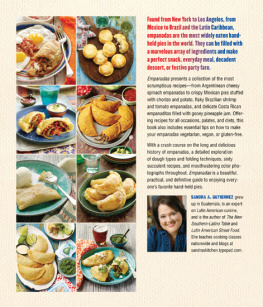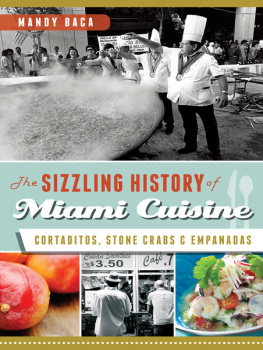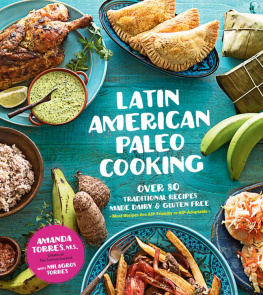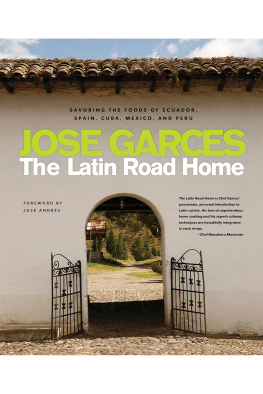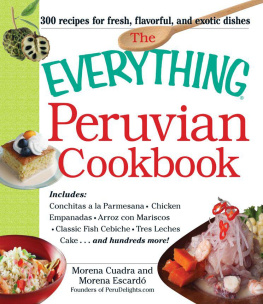

CONTENTS


Ive always been a curious person. I love boxes, baskets, and anything that can hide treasures within. When I hold an unopened box in my hand I get the same feeling that I experience when I hold an empanada for the first time: fascination and a curiosity to discover what scrumptious surprises lie hidden inside. Its this curiosity that has made it so fascinating for me to research the history of food. Its what leads me to want to learn why we eat what we eat, where our food comes from, and how it has evolved over time. After sleuthing like a detective and finding some answers, I always feel compelled to guess where food will go next. Few stories enthrall me more than the evolution of the empanada, because we can trace it back to ancient times but it continues to evolve today.
AT THE BEGINNING
The name empanada derives from the Latin in panis, or in bread. In Spanish, empanar means to encase in bread, and empanadas are hand-held pockets stuffed with a marvelous array of fillings. Many cultures have a tradition of hand-held pies: Italy has calzones, Jamaica has patties, India has samosas, and Britain has pasties. Nevertheless, no other culture has a larger compendium of hand-held pies than Latin America.
Empanadas have an early history wrapped in wars and conquests. The very first empanadas most likely originated in Persia, where travelers and laborers alike turned to this humble food for comfort and nourishment in ancient times. In fact, we can trace the origins of hand-held pies as far back as the year 250 BCE, and to the territory that is modern-day Iran. In order to preserve foods, the Persians used to encase fillings in rustic dough. Not only did the dough keep the fillings from spoiling, but it also made them highly portable. The dough itself was not necessarily meant to be eaten at first, although it morphed into an edible case. These moveable meals were ideal for nomadic cultures, shepherds, and for the legions of soldiers who traveled constantly in their quest to expand the Muslim empire. Today, in the Middle East, we can still find fatays or esfiha (made with wheat flour and filled with lamb), which are perhaps the closest relatives of the first filled pastries.
Empanadas appeared wherever the Ottoman Empire left its imprint and began to be known under different names in the many countries the Ottomans conquered. Once they found their way into Spains territories, however, all of these bread-encrusted meals became known in the Spanish language simply as empanadas. And by the time the Muslims were expelled from Spain in the 1400s, these hand-held pies had spread throughout Europe. For example, ancient Romans encased sheeps milk cheese in thin sheets of pastry similar to phyllo dough.
EMPANADAS TO GO
Empanadas have always been lauded for their portable characteristics, and as convenient on-the-go sustenance the empanada was a favorite of pilgrims. Ancient stone sculptures in the city of Santiago de Compostela in Galicia, Spain, illustrate scenes of pilgrims in search of Saint Jamess tomb, carrying empanadas for their long expeditions.
Being tantalizingly delicious and portable is precisely why empanadas were able to spread around the world. Shortly after the Ottoman Empire fell, the Spanish Empire began its global expansion, and consequently the territory occupied by empanadas also spread. Wherever the conquistadores went, so did these edible parcels. The first empanadas arrived in the Americas in the early 1500s. The most common fillings consisted of minced lamb, studded with raisins and seasoned with spices in the Arab style; fish, as was customary in Galicia; and cheese, as was traditional in some Middle Eastern and Mediterranean cultures. To this day, the most frequently found empanadas in the Latin American landscape still feature fillings that derived from those dating back to medieval timesmost particularly from the Moorish mishmash of meat, onions, dried fruits, eggs, and spices.
What happened next was numerically astonishing, as each Latin American country began to multiply empanada recipes exponentially, giving these their own twists and replacing the traditional ingredients with those native to each area. By now, each country and region within each country offers a plethora of permutations. So, while the sixteenth century may have been when hand-held pies entered the culinary landscape of Latin America, the twenty-first century marks the period when empanadas have reached the zenith of popularity. Today, empanadas are more in vogue than ever before.
EMPANADAS TODAY
Empanadas are still as portable today as they were centuries ago, and this makes them ideal for modern times when eating on the go is the norm. In Latin America, children often find empanadas lovingly tucked into their lunchboxes, and busy people carry boxes filled with empanadas home after work to set up for impromptu entertaining. In fact, you will find empanadasand not tortillas, which are not found past Central America as they are replaced by other flatbreads such as arepas and cachapason tables from Mexico all the way to Argentina.
Empanadas in modern-day Latin America are enjoyed in restaurants, sold by street food vendors, and prepared by home cooks alike. Some are sold by merchants near sports stadiums or bus terminals, such as the Guatemalan peanut and chocolate empanadas. Other empanadas are solely found in the vicinity of churches on Sunday mornings, such as the Colombian empanadas de parroquia or parish empanadas, filled with beef and potatoes. Another famous example of these empanadas is called vaticana (from the Vatican), filled solely with potatoes, which are sold in the porticos and plazas of churches in Medelln. In fact, it is said that many churches in Colombia have been built and restored thanks to empanada bake sales. Since empanadas are not expensive to make, selling them is often a great means to raise funds.
Empanadas also have an economic role in the lives of many Latin American home cooks (particularly women), who depend on selling empanadas to sustain their families. Most of the street vendors who sell empanadas are widows, single mothers, or low-income women who use the money provided by their sales to raise their children and to help their families subsist.
Some empanadas are traditionally eaten only during certain holidays, such as the empanadas Gallegas stuffed with tuna, which make their appearance every year during the Lenten season throughout the entire Latin American continent. Others, such as the pastelitos de membrillo (quince empanadas), are commonly eaten mid-afternoon with a cup of coffee or tea in Argentina as everyday fare. Empanadas are so central to Latin American culture that many places hold entire festivals around them (for example, the Fiesta de la Empanada in Concn, Chile, and the many different fiestas de la Saltea held from Salta, Argentina, to Cochabamba, Bolivia).
SOMETHING FOR EVERY PALATE
Modern-day Latin American empanadas are stuffed with everything from corn, cheese, meat, fowl, seafood, vegetables, herbs, and fruits to caramels (called
Next page
